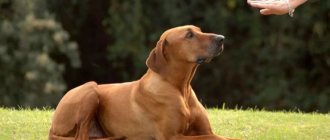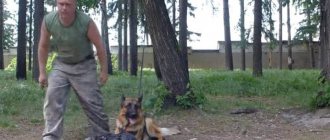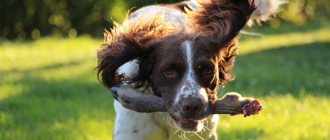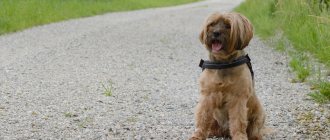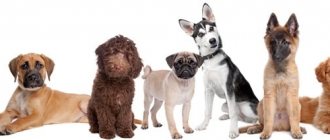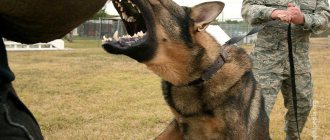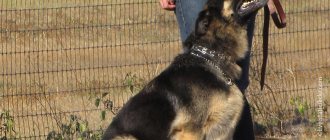Team "Stranger!" for dogs is part of the block of commands of the protective guard service (PSS). Such commands are aimed at protecting the owner, family, territory and property. Therefore, the command “Alien!” is practiced in parallel with the commands “Guard!” and “Fas!” We will tell you how to teach a dog the command “Stranger!” and what mistakes should be avoided when training.
Preparing for training: Photo
A little theory
Do not confuse the two orders “Alien” and “Fas”. The first is an intermediate step before training a dog to attack and actively defend.
What does the “Alien” command mean? If a stranger shows visible aggression, the animal should become wary, growl or bark actively, but under no circumstances should it rush at the person. In its literal sense, an instruction does not require the animal to perform specific actions, but puts it into a state of alertness or high alert.
You can start classes only after learning simple commands, such as “Sit”, “Lie down”, “Stand”, etc. provided that the latter are well studied and the animal obeys the first time.
The ideal age is six months and older; before this time it is better not to get carried away with training malice or aggression, otherwise the animal will grow up nervous and intimidated.
When should you start training a Husky?
You should not require a two-month-old puppy to understand the “sit” command. Where to start? Before moving on to training, it is important to instill in the dog the basic rules of interaction with the owner and other creatures nearby. This needs to be done from the first days of living together. The most important rule is to show that you are the leader, otherwise the dog will quickly take over the leadership. You should not be touched when the puppy plays around or chews something. The first thing you should do to raise a puppy:
After the puppy has mastered the basics, he is accustomed to the street. It is important to be patient if the puppy does not accept the muzzle and leash, is afraid of other people, or cannot immediately get used to relieving itself outside. There is no need to show physical strength; the best education is encouragement. Puppies are very active, curious and friendly. Try to help the husky socialize; choose who the puppy meets. Aggressive large dogs can frighten your puppy.
The first commands that a husky should learn are “ Come ”, “Sit ”, “ Look ”.
Is it worth learning
Before making a decision to teach or not to teach, you need to clearly determine for yourself whether it is really necessary to develop aggression in your pet and whether it can be subsequently controlled.
With improperly structured training, especially with dogs of an unbalanced excitable type, it is very easy to disrupt the psyche and instead of an obedient and friendly dog, you can “raise” an angry and uncontrollable beast.
This is how it was noticed:
- Dogs of large, service breeds undergoing training, even without targeted training, will protect their owner in dangerous situations, especially if friendly relationships have been established between them.
- On the other hand, small animals or representatives of decorative breeds, although they easily learn to show an active defensive reaction, but what is the point of this? Its non-intimidating appearance and small dimensions are unlikely to frighten anyone much.
- Problems are possible when inept training leads to hostility towards the owner or family members and such an animal literally becomes a killing machine.
There are also positive aspects: the puppy, and subsequently the adult animal, ceases to fawn and trust all passers-by or strangers appearing on its territory.
When should you start training a Husky?
Raising a dog should begin in the very first days after it gets to its new owner. However, the concepts of “education” and “training” should not be confused. Up to three or four months, the puppy only needs to be taught good manners, taught the rules of behavior, as well as how to interact with people and other animals. So, at the age of one and a half to two months, the puppy is already able to learn the following points:
You need to train your dog from a very early age.
Then the puppy is taught such things as an adequate attitude towards a collar, leash and muzzle, and is introduced to the street, while at the same time helping the puppy to master the toilet during walks. The puppy will quickly learn the listed skills if the owner shows a patient and gentle attitude.
There is no need to scold the puppy if he is afraid of transport or crowds of people, and you should also not be angry with the baby who could not wait to go for a walk and relieved himself indoors. You need to respond to a small dog's mistakes gently, encouraging correct behavior and ignoring fears.
Socialization is extremely important for a husky puppy.
At the age of three to four months, the puppy needs to be actively socialized - show him as many new things as possible, take him on various trips, build new routes for walks. Huskies have a flexible psyche and animals adapt well to all situations if they actively learn about the world around them from childhood. You also need to introduce your little husky to other dogs.
To do this, you need to choose good-natured and non-aggressive dogs with whom the puppy will start playing. This way, the dog will understand that its relatives can be excellent entertainment partners, and will not try to dominate or show aggression in adulthood.
Scheme of work
Teaching a dog the “Stranger” command is only possible with the help of helpers. It is important that they are not family members or close friends.
It is best for the classes to be conducted by an experienced instructor who will first determine the type of nervous activity of the dog and generally understand whether it is worthwhile to develop anger with a particular animal or not.
First of all, even before targeted training, it is necessary to ensure that the animal does not have contact from infancy, and certainly does not play with strangers. To do this, it is necessary to prohibit all friends and acquaintances from communicating with the pet; moreover, they must ignore the presence of the puppy. All attempts to fawn are warned by a weak tug on the leash and the warning command “Alien.”
Upon reaching the required age and subject to impeccable obedience to other commands, you can begin classes to develop anger, distrust and wariness towards strangers.
To do this, they involve assistants who are equipped with special protective equipment. The first classes are conducted in a quiet, familiar environment without distracting stimuli.
- The animal is kept on a short leash.
- The helper approaches those standing and shows aggression in any way: he waves his arms or a stick, while actively showing that he is afraid of the dog.
- At the same time, while continuing to hold the dog on the chain, they pronounce the command “Alien”. It is very important to use intonation to convey to the animal about the existing threat.
- If the pet shows any kind of hostility (growling, barking, or the dog begins to rush at the “stranger”), repeat the command again and reward the animal with a treat.
After a while, when the animal completely calms down and comes to its senses, the exercise is repeated. You cannot conduct lessons more often than two or three times in one lesson.
Husky character and temperament
The Husky breed belongs to the primitive type, which means that it appeared as a result of the process of natural selection. The first owners of Siberian huskies were the aboriginal inhabitants of the North of Siberia, who made them suitable for riding. Under these conditions, the character traits of these dogs were formed. For example, Siberians are not suitable as guards and watchmen: thousands of years next to peaceful cattle breeders have made them completely devoid of aggression.
The next trait is a heightened hunting instinct. Nomadic peoples fed dogs only in winter, but in the warm season they fed on their own. Inexperienced breeders often have many problems with neighbors who lose cats, chickens, rabbits, and sometimes small livestock.
So, the main character traits of this breed:
All these traits indicate the need for strict training.
If the dog is not aggressive
There are animals that do not show any malice towards a stranger. In such situations, it is necessary to compromise and bring in heavy artillery. Here are some ways:
- the assistant “attacks” the owner;
- the assistant imitates taking away food from the owner, which is intended for the dog;
- During the “attack” the ill-wisher inflicts light blows on the animal.
It is important not to overdo it with physical violence: the animal develops malice, not cowardice. Therefore, blows should not be strong or cause severe pain - they should only inflame aggression and active defense.
It is for this reason that the assistant must be experienced and carefully monitor the student’s behavior, and if necessary, retreat in time so as not to overwhelm the dog. The dog must always remain a “winner”!
Naturally, at the moment of manifestation of any kind of wariness or malice, they pronounce the command “Stranger” and reward the animal in a convenient way (affection, encouraging words, treats). It is advisable not to abuse taste rewards.
After some time, the animal develops an active defense, it becomes distrustful of any stranger and is no longer afraid of blows.
Basic
The earlier training begins, the more impressive the results will be. You can start learning basic commands from the very first day the puppy is with the owner.
It is the impeccable execution of basic commands that will help the owner avoid unpleasant situations (for example, the indignation of a passerby whose clothes have been soiled by a running puppy) and will ensure the safety of the pet itself (in particular, the “come to me” command will force the dog to run up to the owner, and not go out onto the roadway).
The list of basic commands is small, but each of them must be carried out by the dog without delay. The first thing you should teach your shepherd dog is the “come to me” command. It is given by the owner when the pet needs to be called.
To accustom it to it, you should say “come to me” when the dog is called for feeding, to pet or play with it, and so on - that is, the shepherd dog must know that after approaching it will receive a pleasant reward. After the Kafka dog came up and received praise, it was released with the word “walk.”
Important! You cannot punish a dog if it does not immediately run up to the owner, and it is also prohibited to independently move towards the puppy. As soon as your pet approaches, you should immediately praise him and treat him with a treat.
“No” and “Fu” are used by owners to stop unwanted actions of the pet. It is better to practice them in a confined space or while keeping the dog on a leash. In the first case, a dog performing an undesirable action is punished with a gentle slap (for example, with a rolled up newspaper) and a spoken word, and in the second, with a sensitive tug of the leash, and the action is accompanied by a command.
The owner needs to be consistent - he should not allow the dog at a young age to do things that would be prohibited for an adult pet.
The algorithm for teaching a shepherd dog other commands is as follows:
- “Sit” - the puppy stands in front of the owner, who has a treat in his hand. The owner holds the hand with the treat above the dog’s head, while simultaneously pressing the puppy’s croup with the other hand and says “sit.”
- “Lie down” - performed by the dog from a sitting position. The owner passes his hand with a treat clamped in it in front of the dog's muzzle forward and down to the ground. Actions are accompanied by a single pronouncement of the command word.
- “Nearby” - the puppy is led on a leash so that the front part of its body is in line with the owner’s leg, and when the owner stops, the dog must sit down. Attempts to move away from the owner are stopped by a jerk of the leash, and correct execution is encouraged.
Important! Practicing basic exercises begins with 1-3 repetitions, and over time their number increases. The main thing is to finish classes before the puppy gets tired, then he will not lose interest in training
A puppy should not be taught the “voice” command from early childhood, since the really important skills have not yet been learned and wasting effort and energy on this training will take a lot of effort from the baby.
Other training methods
There are alternative methods for teaching a dog the “Alien” command:
- If during a walk the animal independently shows hostility towards a person passing by, then at the same moment the words of the command are pronounced.
- Again, during the walking process, they use the method of surprise, which helps even the most timid pet to awaken the beginnings of protective behavior. To do this, the assistant sneaks up behind the dog and lightly pinches its croup or belly, at the same moment the trainer says “Stranger.” Important: the student must be muzzled, while carefully monitoring the pet’s behavior - this method may not always lead to the desired result and instead of malice, caution will be practiced, and the dog will look around in fear of getting another blow.
How to teach a shepherd the command “Alien!”
Before starting home exercises, the animal must undergo a general training course (GCD). By the time you learn the command “Alien!” The dog must have good endurance and obedience. It is then that the animal becomes absolutely ready for training to protect and protect humans.
Team “Fas!” or “Alien!” belongs to a complex and rather dangerous team. Especially when it comes to more serious dog breeds: Central Asian and Caucasian Shepherd Dogs. You can teach a dog defense when it has good endurance and unquestioning execution of other commands.
You can start working with a German or East European Shepherd (VEO) puppy from 6-9 months, and with an adult - from absolutely any age. As for Alabai and Asians, it is recommended to start the training process with them as early as possible. It is important to show the dog from puppyhood who is boss in the house. Otherwise, the dog will be difficult to control in the future.
Don't forget, shepherds have a strong predatory instinct, so you need to be careful when training.
You can train a shepherd dog with the help of an experienced dog handler, or you can start training yourself, but with the help of a brave and reasonable assistant.
Training equipment
What you will need for training:
- a person who will initiate an attack on the owner;
- protective clothing;
- strong leash;
- rod and durable fabric.
Before starting any activity, the dog needs to expend accumulated energy and relieve itself, then it will be completely focused on its owner.
You should work in an area where there are no factors that can distract you from training—a forest or a stadium would be an excellent option.
Learning process
You can teach a German Shepherd a foreign command as follows:
- The animal is tied tightly to a tree on a short leash. It is important to provide the dog with free movement so that it can move from side to side.
- The owner, or the one who will train the dog, must stand next to the animal, the attacker remains aside.
- Next, the assistant needs to approach the owner and start behaving aggressively: actively waving his arms, raising his voice, hitting the ground with a rod. Thus, the dog must understand that the owner is in danger.
- The next step is for the owner to loudly and clearly give the “stranger” command. In most cases, already at this stage the animal will take the initiative to protect the person. The German Shepherd is one of the few breeds that lends itself well to training this command.
- After the dog begins to actively show aggression towards the attacker, it should be rewarded. It’s enough to pat the dog on the head and say “well done” or “good” (depending on what word the dog was praised during OKD). It is worth taking into account: when an animal is being trained, it is praised and rewarded with food, but during training for the defense command, it is absolutely forbidden to feed it; ordinary praise is enough.
- The training does not end there; force is then used. The attacker tries to show aggressive behavior towards the animal: lightly hit with a rod (not causing pain, but only discomfort), while simultaneously waving a thick cloth. When a dog tries to bite a person, a cloth is presented to it. During the fight, the owner periodically repeats the command and always praises the correct execution. At the very end, the aggressor shows defeat and runs away, to which the dog again receives praise.
- To consolidate the team, the training process is repeated several more times.
By doing everything strictly according to the instructions, you can quickly train a German Shepherd and achieve the desired result.
Possible mistakes
Mistakes always lead to undesirable and unexpected results - improper training will lead to excessive aggression, and superimposing malice on natural cowardice can cost the life of the owner or those around him.
- Protection training begins after six months of age (the later the better). Until this moment, the pet must live and grow exclusively in friendly conditions.
- Only strangers are recruited as assistants. By the way, the assistant in each lesson should be different, otherwise an active defensive reaction will be developed exclusively against a specific person.
- During work, the animal is not allowed off the leash and is not allowed to attack an ill-wisher.
- Training is carried out only after mastering the basic disciplinary commands: “Sit”, “Come to me”, “Fu”, “Next”, etc.
- Punishment cannot be applied in the absence of correct actions, otherwise the animal will be even more afraid.
- Also, you should not punish your pet if he continues to show good nature to the first person he meets. At such moments, the puppy is distracted, and people are forbidden to make any contact with the baby.
With the right approach, the “Alien” command can be useful in everyday life: it will not give the opportunity to steal an animal, and a growl can scare an intruder, which will ultimately protect the owner from attack.
Facts about Husky character and temperament
Huskies as a breed were formed in very specific conditions - they were bred in the northern territories, caring only that these hardy, intelligent and fast dogs would help people, effectively replacing transport in difficult conditions. Accordingly, Husky dogs had to perform two functions: work in a team and tirelessly pull sleds with loads or people. Therefore, no one demanded obedience from dogs (in the modern classical sense), as well as the qualities of a companion or guard.
Sled dogs are highly independent
In addition, huskies have always been those dogs that are capable of making decisions on their own. Since the fate of the person and the cargo depended on the dogs, and especially the leader of the team, the dogs independently chose a safer path, avoiding predators and dangerous places, and also sensed the approach of bad weather. Accordingly, independence is a quality that is fully inherent in huskies, and modern dogs are endowed with it no less than their working ancestors.
The second quality characteristic of huskies is imitation. Initially, these are dogs that live in packs, travel in harness, and younger dogs always looked at older and more experienced ones, adopting their behavior. In addition, huskies are weakly attached to a specific person, because the handler of the sled could be constantly changed, and the dogs were often sold from musher to musher. Therefore, Husky dogs are much closer to their brothers than to humans.
For a husky, the company of its own kind is extremely important.
Husky character traits:
It is precisely because of the combination of such complex psychological characteristics that huskies are not recommended for beginners, as well as for people who are not ready to devote a lot of time to long walks with the dog, training and obedience training.
Husky: primitive beauty
Yes, many people are captivated by the appearance of the husky, from which it is impossible to take their eyes off. But, you need to understand that behind this wild and primitive beauty lies a complex character. In order to comfortably coexist with a Husky dog, you need to comply with at least one of the two most important points:
Huskies need to be raised from a very early age.
Fas!
Practicing this command should begin only after the pet begins to flawlessly perform the basic ones. It is advisable to conduct training on a training ground, with the participation of an experienced dog handler and the person involved, to whom the aggression will be directed. The algorithm for teaching the “fas” command is as follows:
- the dog is next to the owner;
- the dog walks several times in close proximity to the shepherd dog, causing aggression in it (while waving his arms is allowed);
- as soon as the pet begins to react negatively to the person involved, the owner says “fas”;
- the person involved runs away, and the dog receives praise and a treat.
Important ! Only dogs with a stable psyche can be trained , so as not to provoke the manifestation of unmotivated aggression.
Train a dog to be mean to strangers
Sometimes it is necessary to teach a pet to be angry towards strangers, and also to teach it to bark at strangers. Such methods are used by the owners of private houses and various enterprises where strangers may enter. When a dog has close contact with its owner, sometimes there is no need to cultivate anger. But in most cases, owners turn to a dog handler for help. Only a specialist can help set up training correctly.
Before this, the dog handler must warn that such a command can be dangerous for people around him, that you need to understand the seriousness and know how to pacify the dog. You need to teach an animal to be angry towards strangers from a very early age. By the age of 4 months, the dog should already know the commands “fu”, “come to me”, “stranger”. With the help of a dog handler, you will teach her to be aggressive when you order her. By teasing the dog and catching it, the dog handler will show by his own example that a stranger is dangerous and that action must be taken immediately.
Things to consider before training a shepherd
Before starting training, the following conditions must be met:
- The person demonstrating the attack should not be familiar with the dog, and a person who does not like the animal is not suitable for training.
- During training, the attacker and the trainer should not communicate; they should be separated, otherwise the animal will not understand what is required of it.
- During training, the dog should never be hurt, only teased, irritated and caused slight discomfort. Otherwise, she may get scared, and the attempt to teach her to turn into ordinary defense, which does not mean protection. In such a situation, the dog will defend itself, but not the owner.
- There should be no children or other people in the area while working with the animal;
- After training with fabric, gradually switch to a special sleeve that is placed on the hand so that the dog can grab it.
- Remembering to praise and repeat the command is an integral part of the process.
- The last and most important point is that after a fight the attacker should always run away, this will let the dog know that he has won.
- The learning process is quite easy, but very dangerous. There is always a risk of being bitten, so it is worth remembering a strong leash so that the dog does not break loose, and a tight protective suit.
It is very important before starting to train any dog of the shepherd breed, be sure to pass the OKD, because without knowing the command “Fu!” the animal will be impossible to stop.
